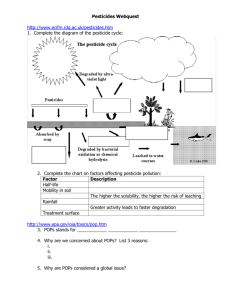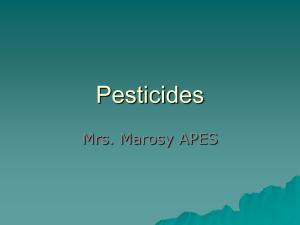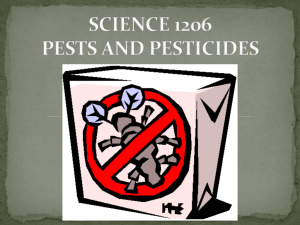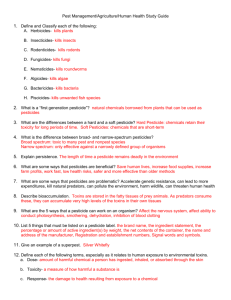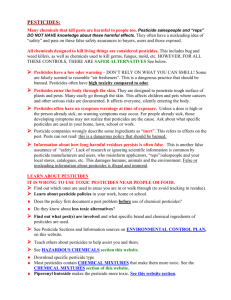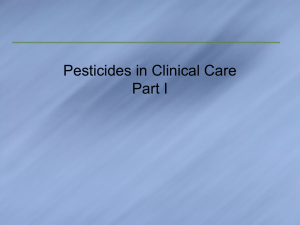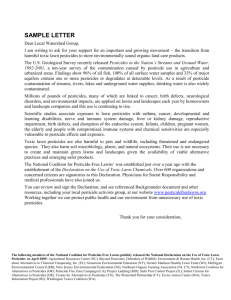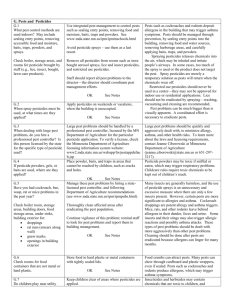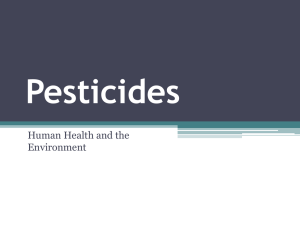Chapter12
advertisement
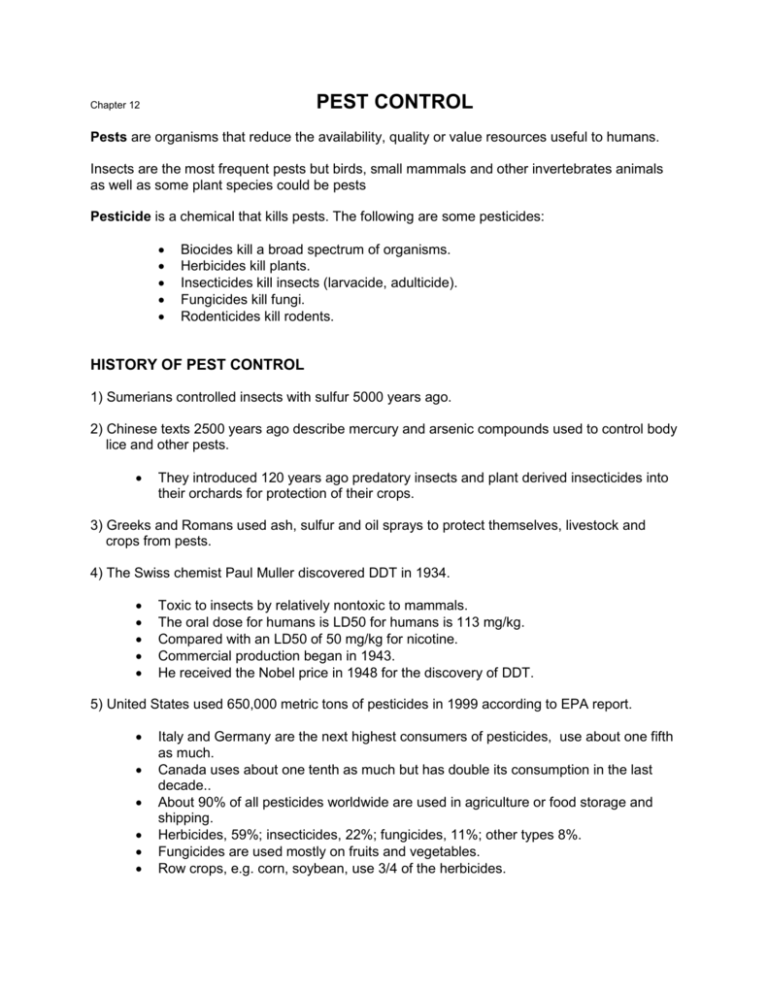
PEST CONTROL Chapter 12 Pests are organisms that reduce the availability, quality or value resources useful to humans. Insects are the most frequent pests but birds, small mammals and other invertebrates animals as well as some plant species could be pests Pesticide is a chemical that kills pests. The following are some pesticides: Biocides kill a broad spectrum of organisms. Herbicides kill plants. Insecticides kill insects (larvacide, adulticide). Fungicides kill fungi. Rodenticides kill rodents. HISTORY OF PEST CONTROL 1) Sumerians controlled insects with sulfur 5000 years ago. 2) Chinese texts 2500 years ago describe mercury and arsenic compounds used to control body lice and other pests. They introduced 120 years ago predatory insects and plant derived insecticides into their orchards for protection of their crops. 3) Greeks and Romans used ash, sulfur and oil sprays to protect themselves, livestock and crops from pests. 4) The Swiss chemist Paul Muller discovered DDT in 1934. Toxic to insects by relatively nontoxic to mammals. The oral dose for humans is LD50 for humans is 113 mg/kg. Compared with an LD50 of 50 mg/kg for nicotine. Commercial production began in 1943. He received the Nobel price in 1948 for the discovery of DDT. 5) United States used 650,000 metric tons of pesticides in 1999 according to EPA report. Italy and Germany are the next highest consumers of pesticides, use about one fifth as much. Canada uses about one tenth as much but has double its consumption in the last decade.. About 90% of all pesticides worldwide are used in agriculture or food storage and shipping. Herbicides, 59%; insecticides, 22%; fungicides, 11%; other types 8%. Fungicides are used mostly on fruits and vegetables. Row crops, e.g. corn, soybean, use 3/4 of the herbicides. PESTICIDE TYPES: Inorganic pesticides: arsenic, mercury, copper, lead. Highly toxic indestructible biocides. Natural organic pesticides or "botanical": nicotine, alkaloids, pyrethrum, turpentine, and phenols. Extracted from plants. Some are biocides. Fumigants: carbon tetrachloride, ethylene dichloride, ethylene dibromide, etc. They gasify easily and are extremely dangerous to humans and animals. Most have been banned. Chlorinated hydrocarbons: DDT, chlordane, aldrin, mothballs, etc. They are synthetic organic insecticides that affect neural signal transmission. They persist in the soil for many years and accumulate in fatty tissues. Organophosphates: parathion, melathion, dichlorvos, TEPP, etc. They affect the nervous system and are extremely toxic but they break down fast, sometimes in a few hours. They are extremely toxic; a drop of TEPP on the skin can kill a human. Carbamates are derived from alkaloids. They are used a herbicides but are toxic to bees. They are biodegradable and have low persistence in the environment. Baygon, zineb, temik are some examples. Microbial agents and biological control. They are living organisms or toxins derived from them. The BT used by the Pest Control Center in Memphis is derived from Bacillus thuringiensis. PESTICIDE BENEFITS Humans compete with other species for food and shelter, and struggle to protect ourselves from disease. 1) Disease control. Insects, ticks, lice, etc. are vectors of diseases. 2) Crop protection. Postharvest losses often amount to 30% of the harvest. Cosmetic damage is reduced. PESTICIDE PROBLEMS 1) Effects on nontarget species. Estimated that 90% of the pesticide do not reach their target. Many beneficial organisms are killed, e. g. honeybees. 2) Pesticide resistance and pest resurgence. Pesticides seldom kill 100% of the target species. Pesticide treadmill: constantly increasing doses, or use newer or more toxic chemicals in order to obtain the same result Resistance transfer from one species to another. 3) Creation of new pests. Beneficial predators keep the prey numbers down. When predators are killed, prey may become a pest. Higher trophic levels are more likely to be affected by pesticides. 4) Persistence and mobility in the environment. Bioaccumulation, ground water contamination. Wind, rain, etc. transport pesticide residue to distant places. 5) Human health problems. Cancer, birth defects, immunological problems are long term effects. Short-term effects include acute poisoning and illness. ALTERNATIVES TO PESTICIDES 1) Behavioral changes. Crop rotation keeps pest populations from building up. Habitat diversification: hedgerows, windbreaks, etc Flooding fields and burning crop residues before planting. 2) Biological controls. Predators: wasps, ladybugs, praying mantises, and pest pathogens. Insect repelling plants: marigolds, garlic, basil and peppermint. Genetic engineering, e. g. sterile males, resistant species. 3) Integrated Pest Management (IPM). Uses a combination of techniques applied at specific times. Mechanical means, minimum use of pesticides. Pest monitoring to determine economic threshold, the point when potential economic damage justifies pesticide. REGULATING PESTICIDES Over 650,000 metric tons of pesticides are used in the United States every year. These pesticides contain over 600 active ingredients combined with 1200 presumably inactive carriers, solvents, preservatives, etc. They are marketed in about 25,000 commercial products. Less than 10% of the active ingredients have been subjected to a full battery of health tests. The study of the inactive ingredients have started recently. Since 1972, 40 pesticides have been banned. Of the 321 pesticides screened so far, the EPA reports that 146 are probable human carcinogens. Three federal agencies share the responsibility for regulating pesticides used in food production. These federal agencies are: 1) Environmental Protection Agency (EPA). It regulates the sale and use of pesticides. The Federal Insecticide, Fungicide and Rodenticide Act (FIFRA) regulates the sale and use of pesticides. It mandates the registration (licensing) of the substance. Federal Food, Drug and Cosmetic Act (FFDA) sets tolerance levels or limits on the amount of pesticide residue may remain on or in foods. Delaney Clause was added to the FIFRA in 1958 prohibiting the addition of any carcinogen to food, drugs or cosmetics. Zero risk approach. The Delaney Clause was replaced in 1996 requiring less stringent standard. Pesticide risks must be weighed against benefits. 2) Food and Drug Administration (FDA). Enforce pesticide and use and tolerance levels set by the EPA. 3) Department of Agriculture (USDA). Enforce pesticide and use and tolerance levels set by the EPA. In Canada, the Pest Control Products Act and Regulations, administered by Agriculture Canada, controls pest control products.



